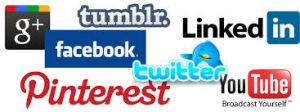Category Archives for business
How to Integrate Social Media into Your Business

Social media has exploded in popularity, so it shouldn’t be surprising that many marketers are advocating its use. There are hundreds of millions of users across multiple social media platforms, and they interact with each other on a daily basis.
The benefits this has to a marketer are clear. The problem is you need to integrate it correctly.
A lot of marketers fail in this pivotal second piece of the puzzle. They may have some sort of social media presence but all of their efforts are disjointed. You’ll need to create an interconnected web of social media accounts that all link back to your main site if you want to get the most out of it.
It all starts with content
Without a collection of strong content on your main site, you won’t have much to share on Twitter or Facebook. Your main focus should always be on your own website and your goal should be to populate it with plenty of good content.
Once a site has been up and running for a while, it’s a good candidate for social media integration. Whenever you post something new, it should get a mention on your social media accounts. This will help maximize the traffic generation offered by every piece of content you post.
Sharing
One of the best ways to do this is to share new content on sites like Facebook. Since you can do this with only a few mouse clicks, it really is one of the easiest ways to extend the usefulness of your content. It can also be a good way to subtly alert your followers to the presence of new content, which will increase the initial traffic it receives.
Quick Updates
Sites like Twitter are wonderful for sending out quick updates about what’s happening on your own site. You should plan to produce a few major, feature type pieces at least once every month.
Twitter can be used to build excitement for this type of content before it gets posted. You can also continue to drive traffic to it after posting by mentioning how popular it is or how busy the discussion threads are.
Tumbling Around
Tumblr is a social media platform that marketers rarely talk about. It is actually one of the most popular sites on the web and is a prime location for finding a younger demographic. The beautiful part about Tumblr is that you can include links back to your site in either text or image posts. Other people can then share or “reblog” what you post, potentially reaching a huge audience.
The real key to social media rests in the integration. It really should be integrated as a part of what you do on your website, and not handled as something else entirely.
You’ll get the most out of social media by creating a website which all leads back to your main site and the offers that can be found there. Or, if you want to have all of this done for you, click here and discover how!
The Four Ps of Marketing

Marketing isn’t easy, and without a proper marketing plan in place, your company may suffer. The main ingredients for a successful marketing campaign are the four Ps. These essential marketing items are the product, price, placement, and promotion. To provide a positive experience for your customers, it is in your best interest to ensure that each P works with all the others.
It takes a lot of work and effort to determine what customers want and need, as well as identifying their shopping habits. Once these steps are taken, you will then need to produce your product, find the right price point, and promote it. All of these actions must be taken together to avoid problems. Let’s explore the four Ps of marketing, determine what they are, and how they work together.
Product
Your product is the heart of your business. It is near and dear to your heart, and if you’ve done your homework, it’s something that is unique to the market, allowing it to stand out from the rest of the competition. The challenge with any product, however, is remaining distinct and unique. From a product perspective, it is best if you have a solid understanding of what customers are looking for in regards to benefits and features.
It’s also imperative that you learn how they will use your product, that way you can make sure the product you’re offering fits their wants and needs. If the product doesn’t fulfill a need, it won’t be likely that customers will purchase it. Perform market research to have a good idea of ways your product will be used.
Price
Of course, your product is only going to sell if you set the appropriate price point. Your business will want to use production costs, projected fulfillment, and other key metrics to determine the proper price for your product. Make sure you are conveying the quality of your product to customers when considering the initial amount of your product. At the same time, do what you can to keep in mind how the price you select, along with costs of manufacturing and production, will have an impact on your product in the long-term.
Placement
In today’s market, placement is no longer simply about identifying the appropriate retailers or best locations. There are now many other channels and outlets to give consideration when thinking about your product placement. Where is the area with the highest foot traffic? Which retailer is showing growth and expansion? What businesses does it make the most sense to establish a partnership with?
These are all questions you will want to consider when it comes to product placement, but you’ll all need to think about the digital aspect of marketing. Will you want to have a social media campaign? Ensuring your product is in a spot which will gain traction and attention in the market is the key to successful product placement.
Promotion
With the continued growth and immersion of our lives into social media, it only makes sense to promote and market your product online. This means that your product marketing needs to be multi-pronged, something that did not require as much attention in the past.
Nowadays, customers want to see the product first-hand. They want to interact with it, ask questions about it, get answers about it and learn more about the brand, all from the comfort of their home. Provide high-quality videos and content to your potential customers, and they will reward you with their loyalty.
Take time to understand each of the four Ps and how they can make or break your marketing campaign. Have a strategy for each ingredient, and focus on trouble spots that may disrupt a successful product. Pay close attention to the four Ps of marketing, but also consider other marketing resources which can accentuate and highlight your product. For more information on the four Ps and other marketing tips, subscribe to DFY now!
Learning to Earn

Everyone wants to make money online. They dream of sitting at home and raking in the millions. While it’s not quite that easy because it does take a lot of work, you actually can sit at home and create a truly profitable business. The key is to find the right educational resources that will point you towards your dreams.
The biggest obstacle with this, however, is the sheer amount of information on the web. The internet was created to share information, so it should come as no surprise that there are mountains of text to sift through. Some information is simply better than others while a small percentage is absolute garbage.
Knowing who to listen to and who to ignore is the key:
Good: Books
Books are always a great place to start learning something new. Sometimes you may have no idea where to start. You know you want to make money online but you just don’t know what to start learning about first. Books are great because you can flip through a few of them and get a better understanding of the subject without having to scavenge for information piecemeal.
After a bit of research, you’ll know exactly what books to track down and what subjects to focus on. Once you pay for a book, it’s yours forever so they can also be great investments. With the rise of e-readers, books are now cheaper and more portable than ever.
Better: Videos
Books are good, but some people are visual learners. They need videos and demonstrations to really be able to wrap their minds around something. Fortunately, there are tons of videos on the web that cover nearly every subject imaginable. Some videos are made by professionals while others are created by amateurs.
There is a big difference in quality between these two different types of videos. Professionals will be able to describe the intricacies of a subject while amateurs can only give a basic overview. Keep in mind, as well, that many videos only show one person’s way of doing things. They might not teach you a different method.
Best: Mentors
Mentors are, without a doubt, the absolute best way to learn something. When you have a mentor you actually have a dedicated, professional teacher who can take you through every step of a process at a speed that works for you. Since most mentors have years of experience in a certain subject, they are a treasure trove of information.
The biggest problem people run into, however, is that effective mentoring can often be rather expensive. These are experienced professionals who can make plenty of money without needing to teach anything. They become mentors because they want to help others, not because they need to.
A good mentor can help you get an online business up and be running faster and more successfully than any other option. If you’re worried about finding a good mentor or being able to pay them well, then you really need to look into our personal 1-on-1 coaching with one of my Top-Tier Coaches. All of my coaches are 6-figure earners and bonafide online marketing experts—check it out!
What is a Sales Funnel?
If you’ve been in the internet marketing world for any amount of time, then you’ve probably heard the term “sales funnel” before. This is a popular concept, but many people still have trouble understanding what exactly a sales funnel is.
It’s really just a way of looking the whole sales process from the first contact until the day they stop buying from you. “Funnel” is a good analogy and makes the process easy to tweak and improve by singling out what steps work and what steps don’t.
A typical sales funnel has a few different steps. For internet marketing, this process begins by generating traffic and directing it to an opt-in form which generates leads. Through interaction with your list, these leads get warmed up and become prospects. When you present them with a great product or offer, some of these prospects will turn into customers.
Attracting New Leads
The first thing to do is to choose an enticing, niche-specific offer, or reason to come to your website. If they’re targeting the weight loss niche, for example, then they will choose an attractive product, service, or website which is targeted to people who want to look and feel better.
Remember that you want to generate traffic that you can turn into leads. You’ll need something enticing enough to get people to your website. Once you’ve picked a lead generation method, the next step is turning this traffic into leads.
Landing Pages and Freebies
The landing page is important because this is what you’ll be directing traffic to. A landing page is just a simple, single page website that presents visitors with a free offer. This freebie is usually something small but attractive. It could be a few short videos, an ebook, or even software. You can either create these freebies yourself or use someone else’s with permission.
Visitors access this free offer by submitting their email address in a form posted on the page. Once they’ve done that, they are now on your mass mailing list. This is how traffic is converted into leads. The entire purpose of the landing page is, in fact, to help grow your list of leads.
Autoresponders
When you generate a new lead, it’s important to contact this person as soon as possible. Since most of us can’t just sit at our computer all day waiting for a new addition to our list, many marketers utilize autoresponders. This is a type of software that will automatically email someone when they sign up, and several times afterward to keep in touch with them.
This email can be used to start building a relationship which turns leads into prospects. The message this software sends can thank the person for signing up, deliver the free product they wanted, and possibly point them in the direction of something else they might like.
Sales Page
The sales page is the end of the funnel (for now). It’s where the leads you’ve generated get turned into paying customers. There are a few different theories on creating sales pages but they generally include an attention-getting headline, some sales copy or a video, information about the product, a call to action, and bonuses to add value to the customer.
The secret to success in internet marketing is creating an effective sales funnel. You can’t simply create a product and hope for it to sell. You need to generate traffic, turn them into leads, follow-up multiple times, and then convert leads into customers.
To help you supercharge your efforts, you can gain insider access to some of the most effective sales funnels and high-converting products in the home business niche today by simply clicking here.

